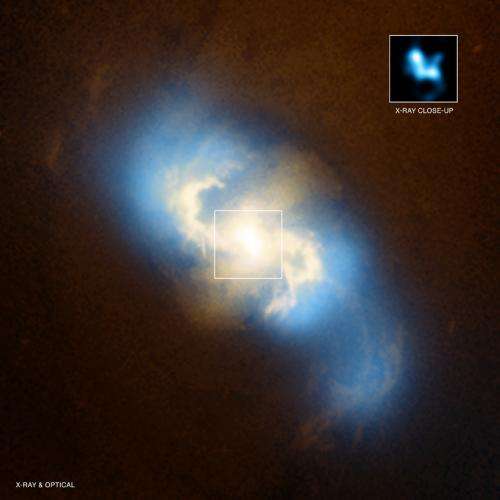Chandra finds nearest pair of supermassive black holes

(PhysOrg.com) -- Astronomers have used NASA's Chandra X-ray Observatory to discover the first pair of supermassive black holes in a spiral galaxy similar to the Milky Way. At a distance of 160 million light years, it is also the nearest known pair of supermassive black holes.
The black holes are located near the center of the spiral galaxy NGC 3393. Separated by only 490 light years, the black holes are likely the remnant of a merger of two galaxies of unequal mass a billion or more years ago.
"If this galaxy wasn't so close we'd have no chance of separating the two black holes in the way we have here," said Pepi Fabbiano of the Harvard-Smithsonian Center for Astrophysics (CfA) in Cambridge, Mass., who led the study that appears in this week's electronic issue of the journal Nature. "Since this galaxy was right under our noses by cosmic standards, it makes us wonder how many of these black hole pairs we've been missing."
Previous observations in X-rays and at other wavelengths indicated that a single supermassive black hole existed in the center of NGC 3393. However, a long look by Chandra allowed the researchers to detect and separate the dual black holes.
Both black holes are actively growing, generating X-ray emission as gas falls towards the black holes and becomes hotter.
When two equal-sized spiral galaxies merge, astronomers think it should result in the formation of a black hole pair and a galaxy with a disrupted appearance and intense star formation. A well-known example is the pair of supermassive black holes in NGC 6240 located about 330 million light years from Earth. However, NGC 3393 is a well-organized spiral galaxy and its central bulge is dominated by old stars. These are unusual properties for a galaxy containing a pair of black holes.
Instead, NGC 3393 may be the first known instance where the merger of a large galaxy and a much smaller one, dubbed a "minor merger" by scientists, has resulted in the formation of a pair of supermassive black holes. In fact, some theories say that minor mergers should be the most common way for black hole pairs to form, but good candidates have been difficult to find because the merged galaxy is expected to look so typical.
"The two galaxies have merged without a trace of the earlier collision, apart from the two black holes," said co-author Junfeng Wang, also from CfA. "If there was a mismatch in size between the two galaxies it wouldn't be a surprise for the bigger one to survive unscathed."
If this was a minor merger, the black hole in the smaller galaxy should have had a smaller mass than the other black hole before their host galaxies started to collide. Good estimates of the masses of both black holes are not yet available to test this idea, although the observations do show that both black holes are more massive than about a million suns. Assuming a minor merger occurred, the black holes should eventually merge after about a billion years.
Both of the supermassive black holes are heavily obscured by dust and gas, which makes them difficult to observe in optical light. Because X-rays are more energetic, they can penetrate this obscuring material. Chandra's X-ray spectra, the distribution of the amount of X-rays with energy, show clear signatures of a pair of supermassive black holes.
The NGC 3393 discovery has some similarities to a possible pair of supermassive black holes found recently by Julia Comerford of the University of Texas at Austin, also using Chandra data. Two X-ray sources, which may be due to supermassive black holes in a galaxy about two billion light years from Earth, are separated by about 6,500 light years. As in NGC 3393, the host galaxy shows no signs of disturbance or extreme amounts of star formation. However, no structure of any sort, including spiral features, is seen in the galaxy. Also, one of the sources could be explained by a jet, implying only one supermassive black hole is located in the galaxy.
"Collisions and mergers are one of the most important ways for galaxies and black holes to grow," said co-author Guido Risaliti, from CfA and the National Institute for Astrophysics in Florence, Italy. "Finding a black hole pair in a spiral galaxy is an important clue in our quest to learn how this happens."
Provided by Chandra X-ray Center



















